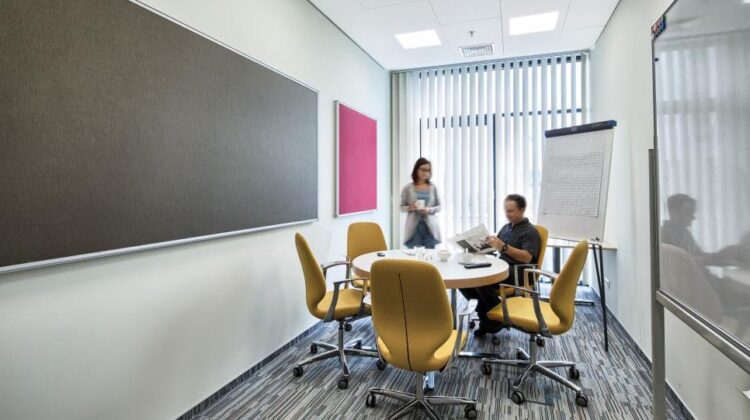
Practical advice to optimise the use of wall absorbers
A wall-to-wall acoustic ceiling is a common solution in many buildings and room types of today. But a wall-to-wall ceiling sometimes just is not enough to create good acoustics – there can be a need for more sound absorption on the vertical surfaces.
Normally, the acoustic treatments of a room consist of a suspended absorbent ceiling. The non-uniform distribution of the sound absorbing material makes the sound field non-diffuse and measured reverberation times generally deviates from what is expected from diffuse field theory. The non-diffusivity is a reason why several parameters are needed showing relations between early and late arriving sound energy. Traditionally the use reverberation time as a measure of the room acoustics in a space is still common. But to create a good acoustic environment more than one parameter is needed to characterize an acoustic experience. The following four acoustic qualities are suitable for common rooms:
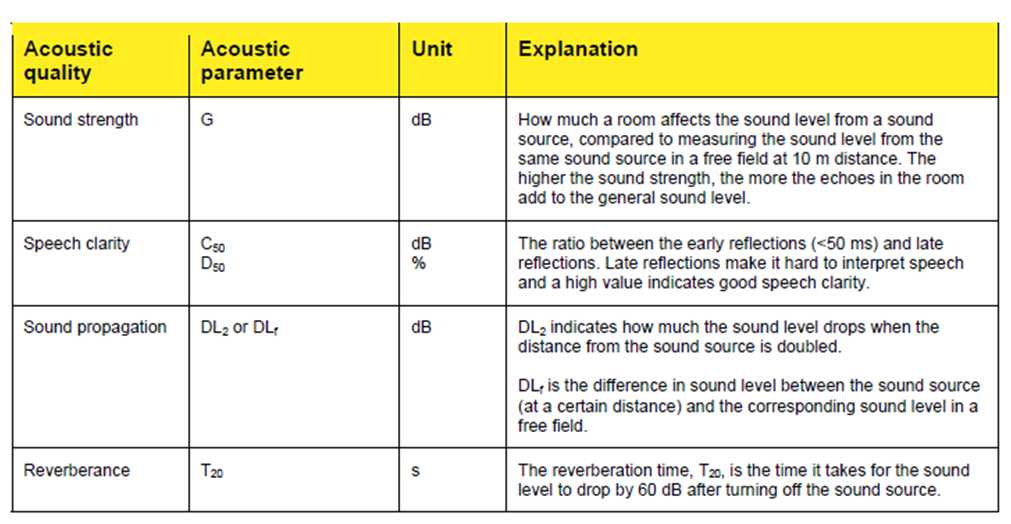
Sound fields – vertical and horizontal
In rooms with absorbent ceilings, we distinguish between two situations; the “steady-state” and the decay situation. In the case of steady-state, a sound source emits sound continuously, with the room thus having a constant level of sound. Even in rooms with absorbent ceilings, the sound is more or less diffuse at steady state. If we switch off the sound source in a room, we will see that the sound waves hitting the acoustic ceiling will disappear first and the sound waves that are reflected off the hard walls will remain longer. The result is a sound field where the sound waves predominantly travel horizontally, almost parallel to the ceiling. Even if the vertical part of the sound field is quickly absorbed, the horizontal persists. The horizontal waves are referred to as grazing waves since they hit the ceiling at a very grazing angle of incidence.
The effect of wall absorbers and absorbing screens
By mounting wall absorbers and/or putting up absorbing screens, the grazing sound waves are effectively absorbed and the total sound field decays faster, i.e. the reverberation time becomes shorter. In addition, introducing vertical absorbers also improves speech clarity, reduces sound propagation and eliminates disturbing flutter echoes. Speech clarity is impeded by late echoes or reflections, for example from a distant wall in a lecture hall. The unwanted late sound reflections from the wall muddle the direct speech from the lecturer. By absorbing the grazing sound waves in a room, unwanted late echoes/reflections are removed and speech clarity boosted. Sound propagation can be very disturbing, for example in an open-plan office where the grazing sounds waves spread without being absorbed by the acoustic ceiling. By using absorbing standing screens and installing wall absorbers the situation will improve. Flutter echoes arise between two parallel walls and can effectively be eliminated with properly placed wall absorbers.
Testing the effect of wall absorbers
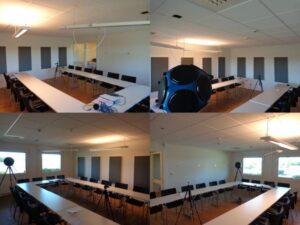
To get a clear view of the effects of acoustic absorbers on walls, a series of acoustic measurements were carried out. The test was performed in a typical meeting room (31 m2) with a wall-to-wall acoustic ceiling. Acoustic measurements were performed with 15 different configurations of wall absorbers (different number of absorbers and location) and compared to a measurement when no wall absorbers were present (the acoustic ceiling was unaltered in all cases).The results confirm that even a relatively small area of wall absorbers has a significant positive effect on the acoustics, even in a space with a wall-to-wall acoustic ceiling.
Figures/tables below show the results of a test series where the number of absorbers was gradually increased. Four measurements with no, one, three and five wall absorbers (W x H = 0.6 x 1.2 m.) installed on one of the walls were performed. The soffit was covered by a wall-to-wall 20 mm sound absorption class A ceiling.
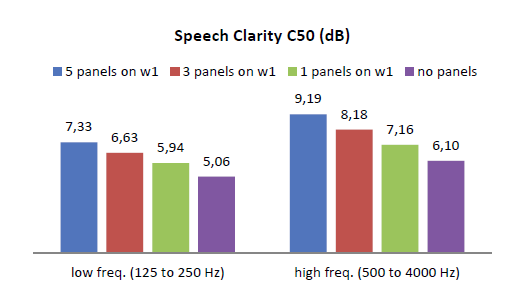
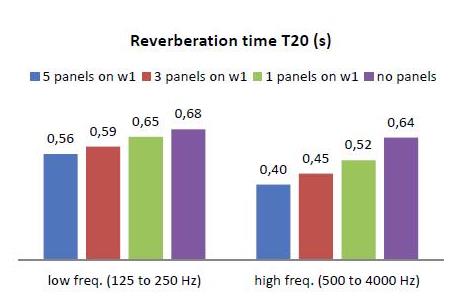
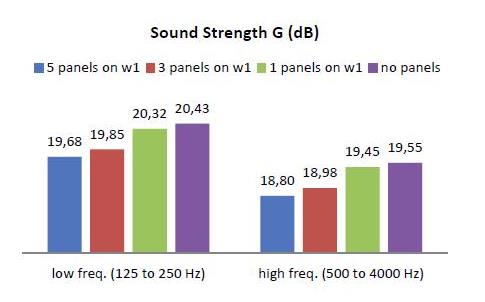
Summary
From the tests, we can draw a number of conclusions regarding the optimum use of wall absorbers. The most important results are that:
- The more vertical absorbers installed in a room, the more will the speech clarity increase and the reverberation time decrease.
- You only need to add a fairly small vertical absorption area to improve the acoustics in terms of speech clarity and reverberation time.
- Adding just one wall absorber in the room resulted in a significant improvement.
- Results improved with the total absorption area in the room.
- Preferably the absorbers should be placed as close to the sound source and activities as possible, and at the height of the listeners’ heads.
- As expected, the sound strength was not as easy to improve. To reduce it you need to add a fairly large area of vertical absorbers.
Results connected to room acoustic descriptors:
- Sound strength – Add as many vertical absorbers as possible in the space. You need a lot of absorption area to make a difference
- Speech clarity – Add vertical absorbers in the room and place them close to the sound source and/or where they eliminate late reflections or flutter echoes. The more absorbers that can be fitted the better clarity, but even a minor vertical absorption area has a significant positive effect
- Sound propagation – Add absorbing screens and wall absorbers to stop grazing sound waves propagating across the room. In some cases, you may even need to add a few free-hanging absorbers below the wall-to-wall acoustic ceiling. In a typical open-plan office, this means installing wall absorbers, using screen absorbers as room dividers throughout the office and placing any free hanging units over the desks
- Reverberation time – Add vertical absorbers in the room. Even a minor vertical area has a significant positive effect
Practical advice reading placement
Larger absorbers: If it is possible to install larger wall absorbers, they should preferably be placed on two adjacent walls to eliminate grazing sound waves.
Smaller absorbers: The size of the total absorption area is important, so the more vertical absorbers you can fit in a room the more you will affect the room acoustic qualities. But even with a smaller vertical absorption area, you can improve reverberation time and speech clarity.
The distances between absorbers, the distribution of the absorbers on the walls and the orientation of rectangular absorbers have a minor effect on the room acoustics. However, the tendencies are:
- Increasing the distance between absorbers increases absorption efficiency (up to 0.5 m apart)
- Distributing the absorbers over different walls is more effective than putting them on only one wall
- Rectangular absorbers work slightly better when placed horizontally, provided they cover the listening/speaking zone
Generally, it’s preferable to position vertical absorbers as close to the sound sources and activities as possible. There should be a distance of about 1 metre between a vertical absorber and any individuals sitting close to it. If you sit too close to an absorber there is a risk of feeling unbalanced. The centre of the absorber should be placed at the height of the speakers’/listeners’ heads when using smaller absorbers.
If you want to explore the variety of vertical acoustic solutions, go here.

